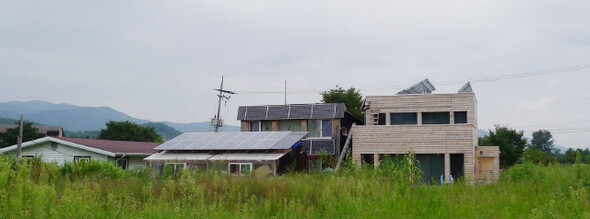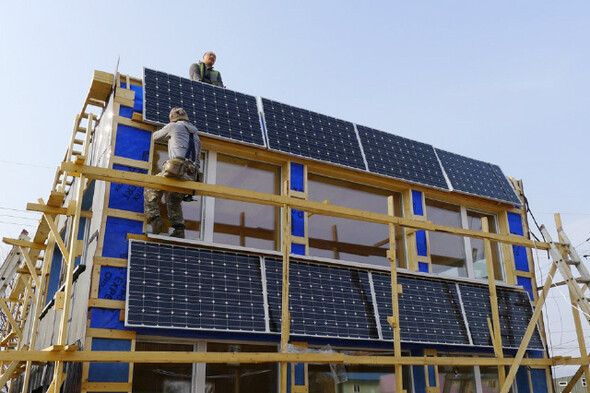hankyoreh
Links to other country sites 다른 나라 사이트 링크
Energy independent houses say goodbye to the grid

Midday temperatures fell to 10 degrees Celsius amid chilly rain on Oct. 31 in the village of Hoehyeon in Yangpyeong County, Gyeonggi Province. But inside the wooden home was cozy and warm, with the thermometer pointing to 24 degrees. Choi Min-kyung, 38, was wearing short sleeves when she came over from another wooden home next door to greet the visitors, her two-month-old baby cradled in her arms.
Both houses are solar-powered: they meet all their heating and electricity needs by harnessing sunlight. They were built without fossil-fuel burning boilers or any hookup to the Korea Electric Power Company (KEPCO) grid. Free from any KEPCO contract, the houses are called “Energy Independent Houses 1 and 2” by their owners.
Most of the solar-powered homes built to date are connected to KEPCO and the grid; they use solar power for electricity during the day, but draw on KEPCO to make up any shortfall at night. The independent houses are a different story: they produce and consume their own energy for heating and cooling, cooking, hot water, ventilation, and lighting.
This is architecturally possible thanks to the construction of “passive houses” with excellent insulation and sealing to control heat flow. Both homes were designed by Lee Pil-ryul, a professor in the department of culture and liberal arts at Korea National Open University. Choi Woo-seok, the 43-year-old occupant of #1, is a researcher at the Energy Independence Institute, and co-builder of the house with Lee.

Inside the homes, ventilation and temperature are controlled by switches rather than boilers or other heating equipment. The windows are large and transparent to let in lots of sunlight, while also serving as a kind of signature of the passive house. At Choi‘s house, the windows are dotted with stickers shaped like birds. The so-called “bird savers” were put up after repeated collisions by small birds that did not see the glass.
Inside the eagle-guarded windows, the interior is warm and simple. The first floor measures 66m², including a living room, a kitchen, and a workspace for husband and wife. Every surface that isn’t a window is filled with books. The couple has a big collection: books also fill the walls of the 33㎡ bedroom on the second floor, and book cases can be found under the bed and window sill. Enamored of the feel of 80-mm thick wood, the owner built the floors with glulam, an engineered wood used for structural building. The trip inside from the crisp, tiny pebbles in the yard onto the first-story floorboards is especially inspiring.
The house next door, where Choi’s younger sister Min-kyung and her husband Yoo Joo-hyeong live, has a similar area and structure. The couple moved in last spring before having their second baby. The idea of a summer without air conditioning would have been unimaginable in their old urban apartment, they said, but even on the hottest days the temperature inside never rose above 26 degrees. The floor in house #2 is fitted with water pipes and heat wires. In the summer, cold water passes around the house in a circuit to provide cooling; in the winter, the electrically powered heating wires heat the floor. The greenhouse in the yard outside houses solar energy generators for heating and electricity in both houses. The generators are linked to solar energy-collecting panels on the roofs.
The houses have all the typical home appliances - a refrigerator, washing machine, TV, computer, and electric heater - and the occupants haven’t experienced trouble operating any of them. The only difference, they said, is that they have had to adopt what they call the “sunflower life.” During the monsoon season, the passive house dwellers adjust their lifestyles to natural conditions - for example, by avoiding using too much water or running the washing machine when heavy rainfall means that there is much less electricity from the warmth of the sun‘s rays. Electricity needs do increase in the winter, but the two houses use no more than 12 kilowatt-hours of energy for heating each year, compared to the 250-kWh demand of a typical 99㎡ building. The savings are possible because the structures strictly follow the principles of passive house construction: thorough insulation and ventilation to redirect heat back into the home. Few houses in South Korea are capable of meeting the 15-kWh and under yearly heating energy consumption criterion for a passive house.

The houses’ designer, Lee Pil-ryul, is also the designer of the Farm Village Experience Center in Yeongyang, Gyeongsang Province, South Korea’s first registered passive house on the website of Germany’s Passive House page (passivhausprojekte.de). In 2011, he built “Energy Independent House #0” by renovating his own home in Seoul’s Jongno District. If that building was an Energy Independence Institution structure and “model home,” then the Yangpyeong houses are the real thing. In lieu of payment for designing the houses, Lee reserved the rights to keep track of their energy usage and to offer “field trips” to show them to visitors at any time.
On that morning, with temperatures in Yangpyeong at 10 degrees, Lee was in Seoul observing the energy usage rates through the electricity monitoring program site Bidgely (bidgely.com). Previously the head of the civic group Energy Change, he traveled to Australia in 2008 to learn about passive house design and gain practical experience.
“When I came back to South Korea, there was the nuclear power disaster at Fukushima in Japan,” Lee explained. “I was thinking about possible alternative approaches to get away from using nuclear power. And the answer seemed clear: we’re never going to get away from issues like nuclear power or the electricity transmission towers in Miryang until we escape from KEPCO.”
The Energy Independent Houses are the alternative he came up with, offering an escape from state authorities, the heavy hand of KEPCO, and fossil fuels - within the walls of his own home, at least. Helping to make the houses a reality were the falling cost of solar power generation installation, which has dropped by three-quarters over the last ten years, and advances in passive house building techniques. Lee’s dream today is to build several more houses, creating a village community whose members interact with each other, not KEPCO.

The houses do cost more than the average to build. With their emphasis on sealing and ventilation, their foundation has to be twice as thick as the floors in other homes. But this cost is offset by the reduced energy spending, Lee said. A typical stand-alone house with the same area as #1 would cost an estimated four million won (US$3,230) a year for heating, hot water, and electricity. After thirty years, the Energy Independent Houses will have saved nearly as much on electricity as the cost of the building. After forty years, the energy savings will be greater than the building costs.
The builders are looking ahead to a long future for energy houses as a confluence of ideals and reality. Choi’s home in #1 is built with deep black carbonized wood. “The wood is black now, but over time it will take on a silver color which makes it sparkle when you see it from a distance,” he explained. “It‘s the same for the Energy Independent Houses.”
By Nam Eun-joo, staff reporter
Please direct questions or comments to [english@hani.co.kr]

Editorial・opinion
![[Column] Park Geun-hye déjà vu in Yoon Suk-yeol [Column] Park Geun-hye déjà vu in Yoon Suk-yeol](https://flexible.img.hani.co.kr/flexible/normal/500/300/imgdb/original/2024/0424/651713945113788.jpg) [Column] Park Geun-hye déjà vu in Yoon Suk-yeol
[Column] Park Geun-hye déjà vu in Yoon Suk-yeol![[Editorial] New weight of N. Korea’s nuclear threats makes dialogue all the more urgent [Editorial] New weight of N. Korea’s nuclear threats makes dialogue all the more urgent](https://flexible.img.hani.co.kr/flexible/normal/500/300/imgdb/original/2024/0424/7317139454662664.jpg) [Editorial] New weight of N. Korea’s nuclear threats makes dialogue all the more urgent
[Editorial] New weight of N. Korea’s nuclear threats makes dialogue all the more urgent- [Guest essay] The real reason Korea’s new right wants to dub Rhee a founding father
- [Column] ‘Choson’: Is it time we start referring to N. Korea in its own terms?
- [Editorial] Japan’s rewriting of history with Korea has gone too far
- [Column] The president’s questionable capacity for dialogue
- [Column] Are chaebol firms just pizza pies for families to divvy up as they please?
- [Column] Has Korea, too, crossed the Rubicon on China?
- [Correspondent’s column] In Japan’s alliance with US, echoes of its past alliances with UK
- [Editorial] Does Yoon think the Korean public is wrong?
Most viewed articles
- 1‘We must say no’: Seoul defense chief on Korean, USFK involvement in hypothetical Taiwan crisis
- 2N. Korean delegation’s trip to Iran shows how Pyongyang is leveraging ties with Moscow
- 3Amnesty notes ‘erosion’ of freedom of expression in Korea in annual human rights report
- 4[Column] Park Geun-hye déjà vu in Yoon Suk-yeol
- 5‘Weddingflation’ breaks the bank for Korean couples-to-be
- 6[Reportage] On US campuses, student risk arrest as they call for divestment from Israel
- 7[Guest essay] The real reason Korea’s new right wants to dub Rhee a founding father
- 8[Editorial] New weight of N. Korea’s nuclear threats makes dialogue all the more urgent
- 9Will NewJeans end up collateral damage in internal feud at K-pop juggernaut Hybe?
- 10Why Korea shouldn’t welcome Japan’s newly beefed up defense cooperation with US